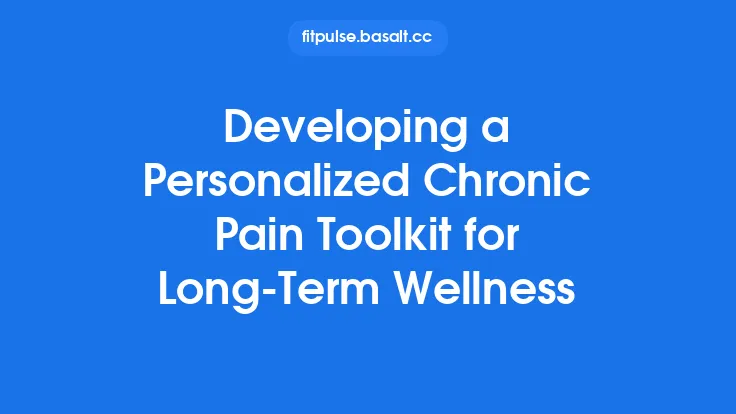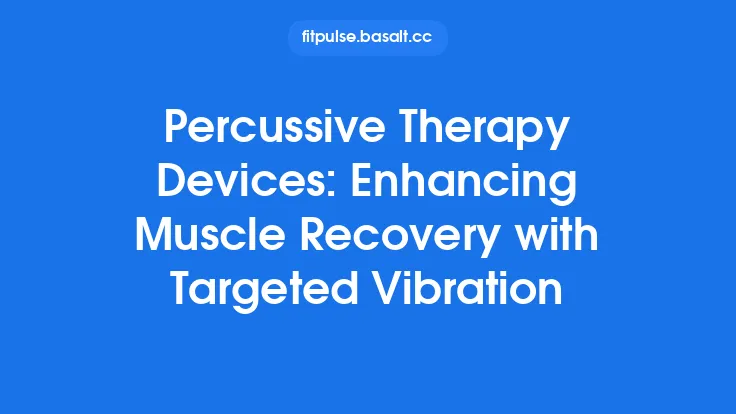Creating a personalized soft‑tissue therapy protocol that supports longevity is less about following a one‑size‑fits‑all routine and more about building a dynamic system that evolves with your body, lifestyle, and health goals. Below is a step‑by‑step framework that guides you from initial assessment through ongoing refinement, ensuring that each session contributes meaningfully to long‑term musculoskeletal health, functional independence, and overall vitality.
Assessing Individual Needs
1. Health History & Lifestyle Audit
Begin with a comprehensive questionnaire that captures:
- Chronic conditions (e.g., hypertension, diabetes, osteoarthritis)
- Past injuries or surgeries affecting soft tissue
- Current training volume, occupational demands, and daily movement patterns
- Sleep quality, stress levels, and nutrition habits
2. Objective Tissue Evaluation
While subjective feedback is valuable, pairing it with objective data creates a robust baseline:
| Metric | Tool | What It Reveals |
|---|---|---|
| Range of Motion (ROM) | Goniometer or digital inclinometer | Joint mobility limitations that may stem from fascial restrictions |
| Tissue Stiffness | Hand‑held elastography device or shear‑wave ultrasound | Quantifies viscoelastic properties of muscle and fascia |
| Pressure Pain Threshold (PPT) | Algometer | Identifies hyper‑sensitive zones that could benefit from targeted release |
| Functional Movement Screening (FMS) | Standardized movement battery | Highlights compensatory patterns that may predispose to injury |
3. Goal Prioritization
Translate the data into concrete, longevity‑focused objectives, such as:
- Preserve or improve hip extension ROM to maintain gait efficiency after age 60
- Reduce chronic low‑back discomfort to support daily activities and sleep quality
- Enhance recovery capacity to sustain high‑intensity training without cumulative tissue damage
Establishing Longevity‑Focused Goals
Longevity in the context of soft‑tissue therapy means maintaining tissue health that supports mobility, resilience, and metabolic function throughout the lifespan. Goal‑setting should therefore incorporate three pillars:
- Structural Integrity – Keep muscles, tendons, and fascia supple and free of adhesions.
- Functional Capacity – Ensure the ability to perform daily tasks (e.g., climbing stairs, lifting groceries) with ease.
- Systemic Well‑Being – Leverage soft‑tissue work to influence circulation, lymphatic flow, and stress response, all of which impact long‑term health.
Each pillar can be broken down into SMART (Specific, Measurable, Achievable, Relevant, Time‑bound) targets. For example: “Increase ankle dorsiflexion by 5° within 12 weeks, measured with a digital inclinometer, to improve balance and reduce fall risk.”
Designing the Core Structure of Your Protocol
A well‑balanced protocol consists of four interlocking components:
| Component | Frequency | Typical Duration | Primary Purpose |
|---|---|---|---|
| Global Mobilization | 2–3×/week | 5–10 min | Reset overall fascial tension, promote circulation |
| Targeted Release | 1–2×/week (or as needed) | 3–8 min per region | Address specific tight spots or post‑exercise soreness |
| Active Reinforcement | Daily (short bursts) | 2–5 min | Teach the nervous system to maintain optimal length‑tension relationships |
| Recovery Integration | Post‑training or on rest days | 5–15 min | Accelerate metabolite clearance and support tissue remodeling |
Key considerations when populating each component:
- Intensity – Use a pressure scale (e.g., 0–10) where 0 is no pressure and 10 is intolerable. For longevity, aim for a moderate 4–6, enough to stimulate mechanotransduction without provoking excessive inflammation.
- Speed of Application – Slow, sustained strokes (30–60 seconds per area) encourage fluid movement within the extracellular matrix, whereas brief, rhythmic passes (5–10 seconds) are better for warming up before activity.
- Volume – Total weekly “soft‑tissue minutes” should align with training load. A sedentary individual may start with 30 min/week, while a high‑performance athlete could require 120 min/week, distributed across the four components.
Choosing the Right Soft‑Tissue Modalities
While foam rollers, massage balls, and manual therapist hands are all viable tools, the selection should be guided by tissue depth, area size, and personal comfort.
| Modality | Ideal Use‑Case | Depth of Penetration |
|---|---|---|
| Foam Roller (medium density) | Large muscle groups (quadriceps, IT band) | Superficial to intermediate |
| Therapeutic Massage (licensed practitioner) | Complex adhesions, deep‑lying trigger zones | Deep |
| Self‑Myofascial Release with a lacrosse ball | Small, hard‑to‑reach spots (glutes, piriformis) | Focused, deep |
| Percussive Device (e.g., handheld massage gun) | Rapid muscle warm‑up, post‑exercise flushing | Variable, depending on head attachment |
Personalization tip: Conduct a brief “tissue‑response test” for each modality. Apply a light pressure for 30 seconds; if the sensation is pleasant and you notice a subtle increase in tissue pliability, the tool is appropriate for that region. If the pressure feels sharp or elicits a strong pain response, either reduce intensity or select a different modality.
Periodizing Soft‑Tissue Work for Long‑Term Health
Just as training cycles are periodized, soft‑tissue therapy benefits from macro‑, meso‑, and micro‑cycles that reflect changing physiological demands.
1. Macro‑Cycle (12–24 months)
- Foundational Phase (0–3 months): Emphasize global mobilization and education. Frequency is higher (3–4×/week) to establish baseline tissue pliability.
- Optimization Phase (4–12 months): Introduce targeted release and active reinforcement. Adjust volume based on training load and emerging needs.
- Maintenance Phase (13 months+): Reduce overall minutes by ~30 % while preserving key high‑impact sessions (e.g., weekly targeted release for chronic tight spots).
2. Meso‑Cycle (4–6 weeks)
- Align with training blocks (e.g., hypertrophy, strength, endurance).
- During high‑intensity blocks, increase post‑training recovery integration to 10–15 min.
- In deload weeks, shift focus to longer global mobilization sessions (15 min) to promote systemic circulation.
3. Micro‑Cycle (Weekly)
- Day‑Specific Allocation:
- Monday & Thursday: Global mobilization + active reinforcement (pre‑workout).
- Wednesday: Targeted release (mid‑week recovery).
- Saturday: Longer post‑session recovery integration after weekend training.
Progression cues: Increase pressure or duration only when the current stimulus yields no further improvement in ROM, pain scores, or functional performance for at least two consecutive weeks.
Monitoring Progress and Adjusting the Plan
A data‑driven approach ensures the protocol remains effective and safe.
1. Subjective Tracking
- Daily Log: Rate overall muscle tightness (0–10), soreness, and perceived recovery.
- Weekly Review: Note any new discomfort, changes in sleep, or alterations in daily activity performance.
2. Objective Re‑Assessment
- Re‑measure ROM, tissue stiffness, and PPT every 4–6 weeks.
- Use a simple “mobility index” (e.g., sum of key joint angles) to visualize trends.
3. Decision Matrix
| Indicator | Action |
|---|---|
| ROM improves ≥5° and PPT rises ≥1 kg | Maintain current dosage; consider modest progression |
| No change after 2 weeks | Increase pressure by 1–2 points or add 2 minutes to targeted release |
| Pain spikes >7/10 or new joint pain | Reduce intensity, shorten session, and consult a healthcare professional |
4. Technology Integration (Optional)
- Wearable EMG or muscle‑tone sensors can flag excessive muscle activation during daily activities, prompting a “quick release” session.
- Mobile apps that sync with your training calendar can automatically suggest soft‑tissue sessions based on upcoming workload.
Integrating Lifestyle Factors for Holistic Longevity
Soft‑tissue therapy does not exist in a vacuum. Its benefits are amplified when paired with complementary lifestyle pillars:
- Nutrition: Adequate protein (1.2–1.6 g/kg body weight) supports collagen turnover; omega‑3 fatty acids modulate inflammation, facilitating smoother tissue remodeling.
- Hydration: Collagen fibers rely on a well‑hydrated extracellular matrix; aim for 2.5–3 L of water daily, adjusting for climate and activity.
- Sleep: Deep sleep stages trigger growth hormone release, essential for tissue repair. Target 7–9 hours of uninterrupted sleep.
- Stress Management: Chronic cortisol elevation stiffens fascia. Incorporate mindfulness, breathing exercises, or low‑intensity yoga on rest days.
By aligning soft‑tissue sessions with these pillars—e.g., scheduling a post‑dinner release after a stress‑reduction routine—you create a synergistic environment that nurtures longevity.
Safety, Contraindications, and When to Seek Professional Help
Even a well‑designed protocol can become hazardous if applied indiscriminately. Keep the following safeguards in mind:
- Acute Inflammation or Open Wounds: Avoid any compressive or friction‑based work until the tissue is fully healed.
- Severe Osteoporosis or Fracture History: Use only very light pressure; consider professional manual therapy instead of self‑application.
- Neurological Conditions (e.g., peripheral neuropathy): Reduced sensation may mask tissue damage; professional supervision is advised.
- Cardiovascular Instability: High‑intensity percussive devices can provoke vagal responses; start with low‑intensity settings.
Red‑Flag Symptoms Requiring Immediate Professional Evaluation:
- Sudden, sharp pain that does not subside after a few minutes
- Persistent swelling or discoloration in the treated area
- Numbness, tingling, or loss of strength beyond the expected post‑exercise fatigue
When any of these arise, pause the protocol and consult a qualified physiotherapist, sports medicine physician, or licensed massage therapist.
Sample Protocols for Different Demographics
Below are three illustrative templates that can be customized further based on the assessment data described earlier.
1. Active Adult (30–45 years) – High‑Volume Trainer
| Day | Session | Modality | Duration | Intensity (0‑10) |
|---|---|---|---|---|
| Mon | Pre‑Workout | Foam roller (medium) – quads, calves | 6 min | 4 |
| Tue | Recovery | Lacrosse ball – glutes, piriformis | 5 min | 5 |
| Wed | Mid‑Week | Percussive device – hamstrings | 8 min | 6 |
| Thu | Pre‑Workout | Global mobilization (foam + dynamic stretch) | 8 min | 4 |
| Fri | Post‑Workout | Therapist‑led deep massage (30 min) | 30 min | 5–6 |
| Sat | Active Recovery | Light self‑myofascial release (full body) | 12 min | 3 |
| Sun | Rest | No formal work; focus on sleep & nutrition | — | — |
Progression: Every 4 weeks, add 1 minute to targeted release or increase percussive device speed by 5 %.
2. Middle‑Aged Professional (50–65 years) – Low‑Impact Lifestyle
| Day | Session | Modality | Duration | Intensity |
|---|---|---|---|---|
| Mon | Morning | Foam roller (soft) – thoracic spine | 5 min | 3 |
| Tue | Evening | Self‑myofascial release (ball) – shoulders | 4 min | 4 |
| Wed | Mid‑day | Light percussive device – calves | 6 min | 4 |
| Thu | Morning | Global mobilization (foam + breathing) | 7 min | 3 |
| Fri | Evening | Therapist‑guided massage (45 min) | 45 min | 5 |
| Sat | Optional | Gentle yoga + soft‑tissue flow | 15 min | 2 |
| Sun | Rest | No formal work | — | — |
Progression: After 8 weeks, introduce a 2‑minute targeted release for any region reporting a pain score >5.
3. Senior (70+ years) – Mobility‑Focused
| Day | Session | Modality | Duration | Intensity |
|---|---|---|---|---|
| Mon | Morning | Soft foam roll – lower back | 4 min | 2 |
| Tue | Evening | Therapist‑guided myofascial release (30 min) | 30 min | 3 |
| Wed | Morning | Light self‑myofascial release (ball) – calves | 3 min | 2 |
| Thu | Evening | Global mobilization (foam + guided breathing) | 5 min | 2 |
| Fri | Morning | Percussive device – gentle sweep of thighs | 5 min | 3 |
| Sat | Optional | Walking + brief self‑release (2 min) | 2 min | 1 |
| Sun | Rest | Focus on hydration & sleep | — | — |
Progression: If ROM improves >5°, increase each session by 1 minute while maintaining low intensity.
Bringing It All Together
A personalized soft‑tissue therapy protocol for longevity is a living system—one that starts with a thorough assessment, translates data into clear, age‑appropriate goals, and then builds a structured yet flexible schedule of mobilization, release, and reinforcement. By periodizing the work, monitoring both subjective and objective markers, and weaving in nutrition, sleep, and stress management, you create a synergistic environment where muscles, tendons, and fascia stay supple, functional, and resilient for decades.
Remember, the ultimate metric of success isn’t just a deeper stretch or a fleeting reduction in soreness; it’s the ability to move through life’s daily demands with confidence, minimal pain, and sustained vitality. Use the framework above as a roadmap, adapt it as your body evolves, and you’ll be well on your way to a softer, stronger, and longer‑lasting you.





